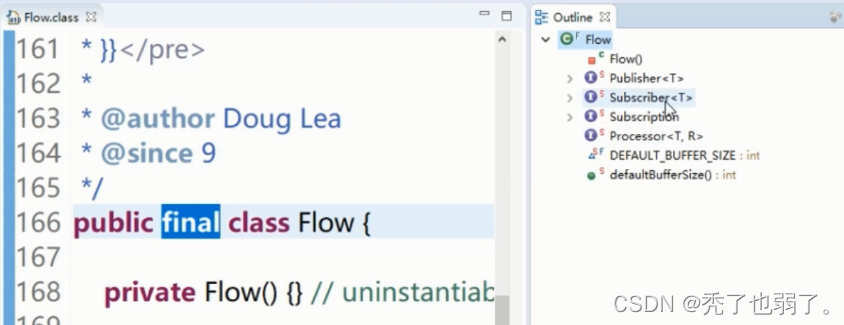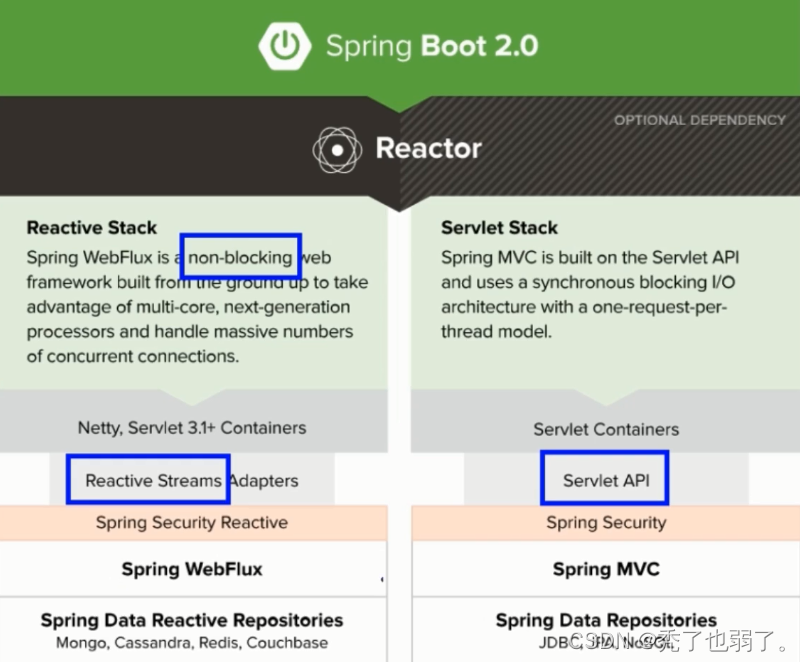目录
三、reactor = jdk8 stream + jdk9 reactive stream
写在前面
Spring Framework 中包含的原始 Web 框架 Spring Web MVC 是专门为 Servlet API 和 Servlet 容器构建的。反应式堆栈 Web 框架 Spring WebFlux 是在 5.0 版的后期添加的。它是完全非阻塞的,支持反应式流(Reactive Stream)背压,并在Netty,Undertow和Servlet 3.1 +容器等服务器上运行。
Spring WebFlux 是一个异步非阻塞式 IO 模型,通过少量的容器线程就可以支撑大量的并发访问。底层使用的是 Netty 容器,这点也和传统的 SpringMVC 不一样,SpringMVC 是基于 Servlet 的。
在此,咱们也简单体验一下spring-webflux到底是个什么东西。
学习webflux之前一定要将jdk8的stream学习明白了哟~
函数式编程-lambda函数与jdk8自带的函数接口_秃了也弱了。的博客-CSDN博客
jdk8-stream深入详解与运行机制_秃了也弱了。的博客-CSDN博客
一、reactive stream(jdk9)


1.Publisher<T>接口发布者
subscribe(Subscriber<? super T>):void:保证发布者和订阅者之间通过此方法建立订阅关系
2.Subscriber<T>订阅者
onSubscribe(Subscription):void:第一此签署订阅关系,输入就是Subscription对象
onNext(T):void:接收到一条数据
onError(Throwable):void:数据出错
onComplete():void:数据处理完了
3.Subscription发布者与订阅者之间的关系
request(long):void:告诉发布者需要多少资源
cancel():void
4.Processor<T,R>接口继承了Publisher和Subscriber,表示既可以做消费者,又可以做发布者,承担中间角色
defaultBufferSize():int
?
?发布-订阅
import java.util.concurrent.Flow.Subscriber;
import java.util.concurrent.Flow.Subscription;
import java.util.concurrent.SubmissionPublisher;
import java.util.concurrent.TimeUnit;
public class FlowDemo {
public static void main(String[] args) throws Exception {
// 1. 定义发布者, 发布的数据类型是 Integer
// 直接使用jdk自带的SubmissionPublisher, 它实现了 Publisher 接口
SubmissionPublisher<Integer> publiser = new SubmissionPublisher<Integer>();
// 2. 定义订阅者
Subscriber<Integer> subscriber = new Subscriber<Integer>() {
private Subscription subscription;
@Override
public void onSubscribe(Subscription subscription) {
// 保存订阅关系, 需要用它来给发布者响应
this.subscription = subscription;
// 请求一个数据
this.subscription.request(1);
}
@Override
public void onNext(Integer item) {
// 接受到一个数据, 处理
System.out.println("接受到数据: " + item);
try {
TimeUnit.SECONDS.sleep(3);
} catch (InterruptedException e) {
e.printStackTrace();
}
// 处理完调用request再请求一个数据
this.subscription.request(1);
// 或者 已经达到了目标, 调用cancel告诉发布者不再接受数据了
// this.subscription.cancel();
}
@Override
public void onError(Throwable throwable) {
// 出现了异常(例如处理数据的时候产生了异常)
throwable.printStackTrace();
// 我们可以告诉发布者, 后面不接受数据了
this.subscription.cancel();
}
@Override
public void onComplete() {
// 全部数据处理完了(发布者关闭了)
System.out.println("处理完了!");
}
};
// 3. 发布者和订阅者 建立订阅关系
publiser.subscribe(subscriber);
// 4. 生产数据, 并发布
// 这里忽略数据生产过程
for (int i = 0; i < 1000; i++) {
System.out.println("生成数据:" + i);
// submit是个block方法
publiser.submit(i);
}
// 5. 结束后 关闭发布者
// 正式环境 应该放 finally 或者使用 try-resouce 确保关闭
publiser.close();
// 主线程延迟停止, 否则数据没有消费就退出
Thread.currentThread().join(1000);
// debug的时候, 下面这行需要有断点
// 否则主线程结束无法debug
System.out.println();
}
}import java.util.concurrent.Flow.Processor;
import java.util.concurrent.Flow.Subscriber;
import java.util.concurrent.Flow.Subscription;
import java.util.concurrent.SubmissionPublisher;
/**
* 带 process 的 flow demo
*/
/**
* Processor, 需要继承SubmissionPublisher并实现Processor接口
*
* 输入源数据 integer, 过滤掉小于0的, 然后转换成字符串发布出去
*/
class MyProcessor extends SubmissionPublisher<String>
implements Processor<Integer, String> {
private Subscription subscription;
@Override
public void onSubscribe(Subscription subscription) {
// 保存订阅关系, 需要用它来给发布者响应
this.subscription = subscription;
// 请求一个数据
this.subscription.request(1);
}
@Override
public void onNext(Integer item) {
// 接受到一个数据, 处理
System.out.println("处理器接受到数据: " + item);
// 过滤掉小于0的, 然后发布出去
if (item > 0) {
this.submit("转换后的数据:" + item);
}
// 处理完调用request再请求一个数据
this.subscription.request(1);
// 或者 已经达到了目标, 调用cancel告诉发布者不再接受数据了
// this.subscription.cancel();
}
@Override
public void onError(Throwable throwable) {
// 出现了异常(例如处理数据的时候产生了异常)
throwable.printStackTrace();
// 我们可以告诉发布者, 后面不接受数据了
this.subscription.cancel();
}
@Override
public void onComplete() {
// 全部数据处理完了(发布者关闭了)
System.out.println("处理器处理完了!");
// 关闭发布者
this.close();
}
}
public class FlowDemo2 {
public static void main(String[] args) throws Exception {
// 1. 定义发布者, 发布的数据类型是 Integer
// 直接使用jdk自带的SubmissionPublisher
SubmissionPublisher<Integer> publiser = new SubmissionPublisher<Integer>();
// 2. 定义处理器, 对数据进行过滤, 并转换为String类型
MyProcessor processor = new MyProcessor();
// 3. 发布者 和 处理器 建立订阅关系
publiser.subscribe(processor);
// 4. 定义最终订阅者, 消费 String 类型数据
Subscriber<String> subscriber = new Subscriber<String>() {
private Subscription subscription;
@Override
public void onSubscribe(Subscription subscription) {
// 保存订阅关系, 需要用它来给发布者响应
this.subscription = subscription;
// 请求一个数据
this.subscription.request(1);
}
@Override
public void onNext(String item) {
// 接受到一个数据, 处理
System.out.println("接受到数据: " + item);
// 处理完调用request再请求一个数据
this.subscription.request(1);
// 或者 已经达到了目标, 调用cancel告诉发布者不再接受数据了
// this.subscription.cancel();
}
@Override
public void onError(Throwable throwable) {
// 出现了异常(例如处理数据的时候产生了异常)
throwable.printStackTrace();
// 我们可以告诉发布者, 后面不接受数据了
this.subscription.cancel();
}
@Override
public void onComplete() {
// 全部数据处理完了(发布者关闭了)
System.out.println("处理完了!");
}
};
// 5. 处理器 和 最终订阅者 建立订阅关系
processor.subscribe(subscriber);
// 6. 生产数据, 并发布
// 这里忽略数据生产过程
publiser.submit(-111);
publiser.submit(111);
// 7. 结束后 关闭发布者
// 正式环境 应该放 finally 或者使用 try-resouce 确保关闭
publiser.close();
// 主线程延迟停止, 否则数据没有消费就退出
Thread.currentThread().join(1000);
}
}二、异步servlet
普通的springmvc就是同步servlet,请求处理线程是阻塞的。
webflux就像是异步servlet,请求接收之后,业务处理交给后台的业务处理线程来执行。
同步servlet
import java.io.IOException;
import java.util.concurrent.TimeUnit;
import javax.servlet.ServletException;
import javax.servlet.annotation.WebServlet;
import javax.servlet.http.HttpServlet;
import javax.servlet.http.HttpServletRequest;
import javax.servlet.http.HttpServletResponse;
/**
* Servlet implementation class SyncServlet
*/
@WebServlet("/SyncServlet")
public class SyncServlet extends HttpServlet {
private static final long serialVersionUID = 1L;
/**
* @see HttpServlet#HttpServlet()
*/
public SyncServlet() {
super();
// TODO Auto-generated constructor stub
}
/**
* @see HttpServlet#doGet(HttpServletRequest request, HttpServletResponse
* response)
*/
protected void doGet(HttpServletRequest request,
HttpServletResponse response) throws ServletException, IOException {
long t1 = System.currentTimeMillis();
// 执行业务代码
doSomeThing(request, response);
System.out.println("sync use:" + (System.currentTimeMillis() - t1));
}
private void doSomeThing(HttpServletRequest request,
HttpServletResponse response) throws IOException {
// 模拟耗时操作
try {
TimeUnit.SECONDS.sleep(5);
} catch (InterruptedException e) {
}
//
response.getWriter().append("done");
}
/**
* @see HttpServlet#doPost(HttpServletRequest request, HttpServletResponse
* response)
*/
protected void doPost(HttpServletRequest request,
HttpServletResponse response) throws ServletException, IOException {
// TODO Auto-generated method stub
doGet(request, response);
}
}异步servlet?
import java.io.IOException;
import java.util.concurrent.CompletableFuture;
import java.util.concurrent.TimeUnit;
import javax.servlet.AsyncContext;
import javax.servlet.ServletException;
import javax.servlet.ServletRequest;
import javax.servlet.ServletResponse;
import javax.servlet.annotation.WebServlet;
import javax.servlet.http.HttpServlet;
import javax.servlet.http.HttpServletRequest;
import javax.servlet.http.HttpServletResponse;
/**
* Servlet implementation class AsyncServlet
*/
@WebServlet(asyncSupported = true, urlPatterns = { "/AsyncServlet" })
public class AsyncServlet extends HttpServlet {
private static final long serialVersionUID = 1L;
/**
* @see HttpServlet#HttpServlet()
*/
public AsyncServlet() {
super();
// TODO Auto-generated constructor stub
}
/**
* @see HttpServlet#doGet(HttpServletRequest request, HttpServletResponse
* response)
*/
protected void doGet(HttpServletRequest request,
HttpServletResponse response) throws ServletException, IOException {
long t1 = System.currentTimeMillis();
// 开启异步
AsyncContext asyncContext = request.startAsync();
// 执行业务代码,为了方便使用jdk8的future
CompletableFuture.runAsync(() -> doSomeThing(asyncContext,
asyncContext.getRequest(), asyncContext.getResponse()));
System.out.println("async use:" + (System.currentTimeMillis() - t1));
}
private void doSomeThing(AsyncContext asyncContext,
ServletRequest servletRequest, ServletResponse servletResponse) {
// 模拟耗时操作
try {
TimeUnit.SECONDS.sleep(5);
} catch (InterruptedException e) {
}
//
try {
servletResponse.getWriter().append("done");
} catch (IOException e) {
e.printStackTrace();
}
// 业务代码处理完毕, 通知结束
asyncContext.complete();
}
/**
* @see HttpServlet#doPost(HttpServletRequest request, HttpServletResponse
* response)
*/
protected void doPost(HttpServletRequest request,
HttpServletResponse response) throws ServletException, IOException {
// TODO Auto-generated method stub
doGet(request, response);
}
}三、reactor = jdk8 stream + jdk9 reactive stream
import java.util.concurrent.TimeUnit;
import org.reactivestreams.Subscriber;
import org.reactivestreams.Subscription;
import reactor.core.publisher.Flux;
public class ReactorDemo {
public static void main(String[] args) {
// reactor = jdk8 stream + jdk9 reactive stream
// Mono 0-1个元素
// Flux 0-N个元素
String[] strs = { "1", "2", "3" };
// 2. 定义订阅者
Subscriber<Integer> subscriber = new Subscriber<Integer>() {
private Subscription subscription;
@Override
public void onSubscribe(Subscription subscription) {
// 保存订阅关系, 需要用它来给发布者响应
this.subscription = subscription;
// 请求一个数据
this.subscription.request(1);
}
@Override
public void onNext(Integer item) {
// 接受到一个数据, 处理
System.out.println("接受到数据: " + item);
try {
TimeUnit.SECONDS.sleep(3);
} catch (InterruptedException e) {
e.printStackTrace();
}
// 处理完调用request再请求一个数据
this.subscription.request(1);
// 或者 已经达到了目标, 调用cancel告诉发布者不再接受数据了
// this.subscription.cancel();
}
@Override
public void onError(Throwable throwable) {
// 出现了异常(例如处理数据的时候产生了异常)
throwable.printStackTrace();
// 我们可以告诉发布者, 后面不接受数据了
this.subscription.cancel();
}
@Override
public void onComplete() {
// 全部数据处理完了(发布者关闭了)
System.out.println("处理完了!");
}
};
// 这里就是jdk8的stream
Flux.fromArray(strs).map(s -> Integer.parseInt(s))
// 最终操作
// 这里就是jdk9的reactive stream
.subscribe(subscriber);
}
}四、webflux初体验

?官方的比对,说是webflux是非阻塞的、支持reactive?stream、并且不支持关系型数据库只支持非关系型数据库。
<dependency>
<groupId>org.springframework.boot</groupId>
<artifactId>spring-boot-starter-webflux</artifactId>
</dependency>我们可以看到,get1就是普通的mvc,get2就是webflux模式,对于用户来说这两种模式体验是一样的。但是对服务器来说,get1是阻塞的,get2是非阻塞的(其实无非是将业务处理放到后台线程,我感觉最终消耗的系统资源其实并没有少,也没有网上吹嘘的那么好,只是并发量高了之后可以接收更多的用户请求,但是处理请求不见得会快多少)。
get3的形式就是会逐个输出每一条数据。
import java.util.concurrent.TimeUnit;
import java.util.stream.IntStream;
import org.springframework.http.MediaType;
import org.springframework.web.bind.annotation.GetMapping;
import org.springframework.web.bind.annotation.RestController;
import lombok.extern.slf4j.Slf4j;
import reactor.core.publisher.Flux;
import reactor.core.publisher.Mono;
@RestController
@Slf4j
public class TestController {
@GetMapping("/1")
private String get1() {
log.info("get1 start");
String result = createStr();
log.info("get1 end.");
return result;
}
@GetMapping("/2")
private Mono<String> get2() {
log.info("get2 start");
Mono<String> result = Mono.fromSupplier(() -> createStr());
log.info("get2 end.");
return result;
}
/**
* Flux : 返回0-n个元素
*
* @return
*/
@GetMapping(value = "/3", produces = MediaType.TEXT_EVENT_STREAM_VALUE)
private Flux<String> flux() {
Flux<String> result = Flux
.fromStream(IntStream.range(1, 5).mapToObj(i -> {
try {
TimeUnit.SECONDS.sleep(1);
} catch (InterruptedException e) {
}
return "flux data--" + i;
}));
return result;
}
private String createStr() {
try {
TimeUnit.SECONDS.sleep(5);
} catch (InterruptedException e) {
}
return "some string";
}
}五、SSE(server?sent?events)
webflux的Flux,就像是SSE一样,可以实现类似向服务器推送资源的功能。
import java.io.IOException;
import java.util.concurrent.TimeUnit;
import javax.servlet.ServletException;
import javax.servlet.annotation.WebServlet;
import javax.servlet.http.HttpServlet;
import javax.servlet.http.HttpServletRequest;
import javax.servlet.http.HttpServletResponse;
/**
* Servlet implementation class SSE
*/
@WebServlet("/SSE")
public class SSE extends HttpServlet {
private static final long serialVersionUID = 1L;
/**
* @see HttpServlet#HttpServlet()
*/
public SSE() {
super();
// TODO Auto-generated constructor stub
}
/**
* @see HttpServlet#doGet(HttpServletRequest request, HttpServletResponse
* response)
*/
protected void doGet(HttpServletRequest request,
HttpServletResponse response) throws ServletException, IOException {
response.setContentType("text/event-stream");
response.setCharacterEncoding("utf-8");
for (int i = 0; i < 5; i++) {
// 指定事件标识
response.getWriter().write("event:me\n");
// 格式: data: + 数据 + 2个回车
response.getWriter().write("data:" + i + "\n\n");
response.getWriter().flush();
try {
TimeUnit.SECONDS.sleep(1);
} catch (InterruptedException e) {
}
}
}
/**
* @see HttpServlet#doPost(HttpServletRequest request, HttpServletResponse
* response)
*/
protected void doPost(HttpServletRequest request,
HttpServletResponse response) throws ServletException, IOException {
// TODO Auto-generated method stub
doGet(request, response);
}
}<!DOCTYPE html>
<html>
<head>
<meta charset="UTF-8">
<title>Insert title here</title>
</head>
<body>
<script type="text/javascript">
// 初始化, 参数为url
// 依赖H5
var sse = new EventSource("SSE");
sse.onmessage = function(e) {
console.log("message", e.data, e);
}
// 监听指定事件, (就不会进入onmessage了)
sse.addEventListener("me", function(e) {
console.log("me event", e.data);
// 如果不关闭,会自动重连
if (e.data == 3) {
sse.close();
}
});
</script>
</body>
</html>